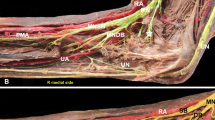Summary
Based on the etiology and on anatomical and functional considerations, the Prague anatomist Čihak developed a new method of regaining the opposition of the thumb in the case of a peripheral paralysis of the median nerve. This method was successfully employed in four cases by the surgeons Eiselt and Fleischmann, and was published in 1963. Here, the technique is demonstrated in a clinical case in which the motor part of the median nerve had been severed at the wrist by a glass splinter. Illustrations are added. Figs. 1 and 2 show the pre-operative condition and Figs. 9 and 10 the function of the thumb 21 months after surgery.
Čihak found that the 1st dorsal interosseus muscle originates from two buds which are connected with two branches of the ulnar nerve, so that the muscle is divisible into two. For practical purposes the origin of the radial part of the 1st dorsal interosseus muscle, along with its adjoining bone, is detached (Figs. 2 and 6).
The radial part of the 1st dorsal interosseus muscle is drawn in the opposite direction from the embryonic migration of the blastem, that is from the dorsal to the volar und radial side (Figs. 2, 7 and 8).
At the insertion of the paralysed opponens muscle a piece of bone of equal size is removed with the cisel (Fig. 7). The piece of bone with the radial part of the 1st dorsal interosseus muscle is fixed in its new position by periostal sutures (Fig. 8). In addition to that, a part of the ulnar sesamoid bone with the insertion of the adductor pollicis muscle is detached, passed under the volar neurovascular bundles to the radial side and fixed to the radial sesamoid bone (Figs. 2 and 5). In this way a new muscular complex is created which allows the opposition of the thumb. The movement is started by the transposed adductor muscle, and is supported and stabilized by the 1st dorsal interosseus (even in a normal hand the interossei take part in the final phase of the pinch).
In comparison with other methods, this one has the advantage of transposing intrinsic hand muscles without changing the direction of their fibres.
Zusammenfassung
Ausgehend von entwicklungsgeschichtlichen und anatomischfunktioneilen Überlegungen wurde von dem Anatomen Čihak und den Chirurgen Eiselt und Fleischmann eine neue Methode zur Wiederherstellung der Opposition des Daumens nach peripherer Medianuslähmung unter Verwendung kurzer Handmuskeln erdacht und erprobt. Aufgrund eigener Erfahrung wird diese Methode anhand von Zeichnungen und Photographien eines klinischen Beispiels vorgestellt. Durch Verlagerung des Ursprungs der radialen Hälfte des M. interosseus dorsalis I auf die Radialseite des I. Metacarpale und der Insertion des M. adductor pollicis vom ulnaren Sesambein zum radialen Sesambein des Daumengrundgelenkes wird ein neuer Muskelkomplex geschaffen. Dabei wird die Bewegung von dem umgelagerten Adductor pollicis eingeleitet, während der M. interosseus dorsalis I in der Endphase des Griffes wirkt. Dieser Muskel ist auch an der normalen Hand besonders an der Endphase des Griffes beteiligt.
Similar content being viewed by others
Literatur
Braus, H., Elze, C.: Anatomie des Menschen, 3. Aufl., Bd. I. Berlin-Göttingen-Heidelberg: Springer 1954.
Čihak, R., Eiselt, B., Fleischmann, M.: Reconstruction of thumb opposition by intrinsic hand muscles. Acta Univ. Carol. Med. (Praha) No 1, 3–26 (1963).
Hill, W. C.: Primates: Comparative anatomy and taxonomy. New York: Interscience Publishers 1962.
Huber, E.: Hilfsoperationen bei Medianuslähmung des Daumens. Dtsch. Z. Chir. 162, 271–175 (1921).
Kaplan, E. B.: Functional and surgical anatomy of the hand. London: Pitman 1965.
Lanz, T. v., Wachsmuth, W.: Praktische Anatomie, 2. Aufl., Bd. I/3. Berlin-Göttingen-Heidelberg: Springer 1959.
Author information
Authors and Affiliations
Additional information
With the authors of the technique we believe that the successful results achieved are based on the correlation of developmental and functional-anatomical considerations.
Rights and permissions
About this article
Cite this article
Lösch, G.M. Wiederherstellung der Opposition des Daumens nach peripherer Medianuslähmung. Chir Plastica 1, 63–71 (1971). https://doi.org/10.1007/BF00289779
Issue Date:
DOI: https://doi.org/10.1007/BF00289779




